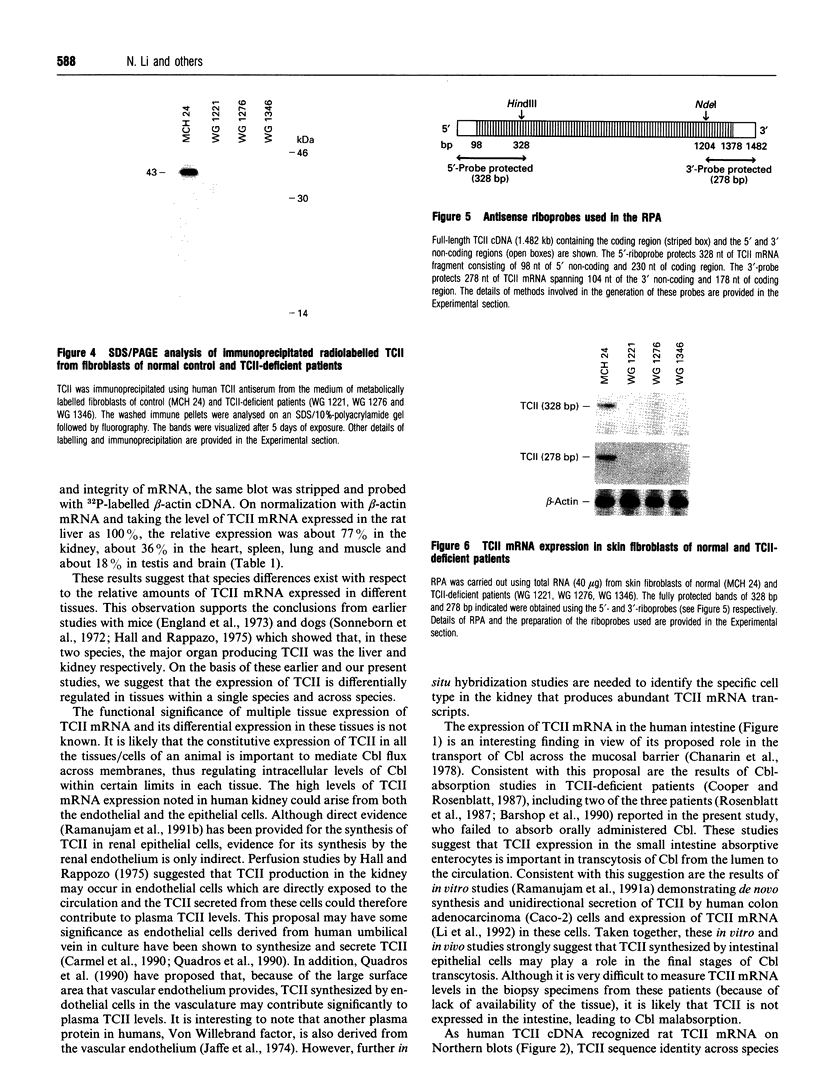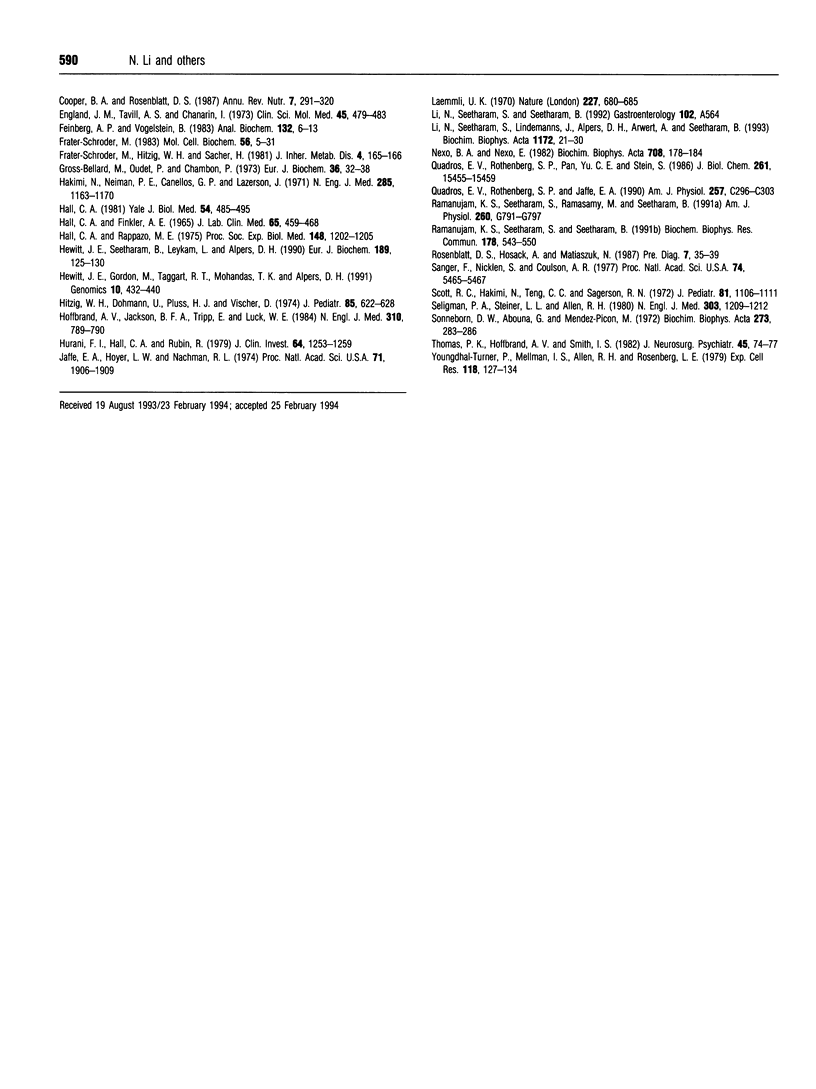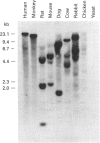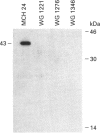Abstract
Transcobalamin II (TCII) is an important plasma transporter of cobalamin (Cbl; vitamin B12). In the present study, TCII gene expression in human and rat tissues and in the fibroblasts of patients with TCII deficiency was investigated. Northern-blot analyses revealed expression of TCII mRNA in many human and rat tissues. In humans, this was 14-fold higher in the kidney than in liver, whereas in the rat the levels of expression were similar in the kidney and liver. Southern-blot analysis of genomic DNA from several species revealed sequence similarity in TCII across species. Metabolic labelling and ribonuclease protection assay revealed a 43 kDa TCII protein and a fully protected TCII mRNA band in normal fibroblasts but not in fibroblasts from three TCII-deficient patients. Southern-blot analysis of genomic DNA from all these fibroblasts revealed identical restriction patterns on BamHI, HindIII, KpnI, MspI and EcoRI digestion. On the basis of these results, we suggest that TCII is expressed in multiple tissues, and its level of expression in tissues varies within the same and across species. Furthermore, the TCII deficiency characterized in this study is due to the absence of TCII protein which in turn is due to the absence or extremely low levels of its mRNA and not to detectable gross alterations in the gene structure.
Full text
PDF





Images in this article
Selected References
These references are in PubMed. This may not be the complete list of references from this article.
- Barshop B. A., Wolff J., Nyhan W. L., Yu A., Prodanos C., Jones G., Sweetman L., Leslie J., Holm J., Green R. Transcobalamin II deficiency presenting with methylmalonic aciduria and homocystinuria and abnormal absorption of cobalamin. Am J Med Genet. 1990 Feb;35(2):222–228. doi: 10.1002/ajmg.1320350216. [DOI] [PubMed] [Google Scholar]
- Berliner N., Rosenberg L. E. Uptake and metabolism of free cyanocobalamin by cultured human fibroblasts from controls and a patient with transcobalamin II deficiency. Metabolism. 1981 Mar;30(3):230–236. doi: 10.1016/0026-0495(81)90146-3. [DOI] [PubMed] [Google Scholar]
- Burman J. F., Mollin D. L., Sourial N. A., Sladden R. A. Inherited lack of transcobalamin II in serum and megaloblastic anaemia: a further patient. Br J Haematol. 1979 Sep;43(1):27–38. doi: 10.1111/j.1365-2141.1979.tb03716.x. [DOI] [PubMed] [Google Scholar]
- Carmel R., Neely S. M., Francis R. B., Jr Human umbilical vein endothelial cells secrete transcobalamin II. Blood. 1990 Jan 1;75(1):251–254. [PubMed] [Google Scholar]
- Chanarin I., Muir M., Hughes A., Hoffbrand A. V. Evidence for intestinal origin of transcobalamin II during vitamin B12 absorption. Br Med J. 1978 Jun 3;1(6125):1453–1455. doi: 10.1136/bmj.1.6125.1453. [DOI] [PMC free article] [PubMed] [Google Scholar]
- Chirgwin J. M., Przybyla A. E., MacDonald R. J., Rutter W. J. Isolation of biologically active ribonucleic acid from sources enriched in ribonuclease. Biochemistry. 1979 Nov 27;18(24):5294–5299. doi: 10.1021/bi00591a005. [DOI] [PubMed] [Google Scholar]
- Cooper B. A., Rosenblatt D. S. Inherited defects of vitamin B12 metabolism. Annu Rev Nutr. 1987;7:291–320. doi: 10.1146/annurev.nu.07.070187.001451. [DOI] [PubMed] [Google Scholar]
- England J. M., Tavill A. S., Chanarin I. Hepatic synthesis of transcobalamin II in the rat. Clin Sci Mol Med. 1973 Oct;45(4):479–483. doi: 10.1042/cs0450479. [DOI] [PubMed] [Google Scholar]
- Feinberg A. P., Vogelstein B. A technique for radiolabeling DNA restriction endonuclease fragments to high specific activity. Anal Biochem. 1983 Jul 1;132(1):6–13. doi: 10.1016/0003-2697(83)90418-9. [DOI] [PubMed] [Google Scholar]
- Fràter-Schröder M. Genetic patterns of transcobalamin II and the relationships with congenital defects. Mol Cell Biochem. 1983;56(1):5–31. doi: 10.1007/BF00228765. [DOI] [PubMed] [Google Scholar]
- Gross-Bellard M., Oudet P., Chambon P. Isolation of high-molecular-weight DNA from mammalian cells. Eur J Biochem. 1973 Jul 2;36(1):32–38. doi: 10.1111/j.1432-1033.1973.tb02881.x. [DOI] [PubMed] [Google Scholar]
- HALL C. A., FINKLER A. E. THE DYNAMICS OF TRANSCOBALAMIN II. A VITAMIN B12 BINDING SUBSTANCE IN PLASMA. J Lab Clin Med. 1965 Mar;65:459–468. [PubMed] [Google Scholar]
- Hakami N., Neiman P. E., Canellos G. P., Lazerson J. Neonatal megaloblastic anemia due to inherited transcobalamin II deficiency in two siblings. N Engl J Med. 1971 Nov 18;285(21):1163–1170. doi: 10.1056/NEJM197111182852103. [DOI] [PubMed] [Google Scholar]
- Hall C. A. Congenital disorders of vitamin B12 transport and their contributions to concepts. II. Yale J Biol Med. 1981 Nov-Dec;54(6):485–495. [PMC free article] [PubMed] [Google Scholar]
- Hall C. A., Rappazzo M. E. Release of transcobalamin II by canine organs. Proc Soc Exp Biol Med. 1975 Apr;148(4):1202–1205. doi: 10.3181/00379727-148-38717. [DOI] [PubMed] [Google Scholar]
- Haurani F. I., Hall C. A., Rubin R. Megaloblastic anemia as a result of an abnormal transcobalamin II (Cardeza). J Clin Invest. 1979 Nov;64(5):1253–1259. doi: 10.1172/JCI109580. [DOI] [PMC free article] [PubMed] [Google Scholar]
- Hewitt J. E., Gordon M. M., Taggart R. T., Mohandas T. K., Alpers D. H. Human gastric intrinsic factor: characterization of cDNA and genomic clones and localization to human chromosome 11. Genomics. 1991 Jun;10(2):432–440. doi: 10.1016/0888-7543(91)90329-d. [DOI] [PubMed] [Google Scholar]
- Hewitt J. E., Seetharam B., Leykam J., Alpers D. H. Isolation and characterization of a cDNA encoding porcine gastric haptocorrin. Eur J Biochem. 1990 Apr 20;189(1):125–130. doi: 10.1111/j.1432-1033.1990.tb15468.x. [DOI] [PubMed] [Google Scholar]
- Hitzig W. H., Dohmann U., Pluss H. J., Vischer D. Hereditary transcobalamin II deficiency: clinical findings in a new family. J Pediatr. 1974 Nov;85(5):622–628. doi: 10.1016/s0022-3476(74)80503-2. [DOI] [PubMed] [Google Scholar]
- Hoffbrand A. V., Tripp E., Jackson B. F., Luck W. E., Frater-Schröder M. Hereditary abnormal transcobalamin II previously diagnosed as congenital dihydrofolate reductase deficiency. N Engl J Med. 1984 Mar 22;310(12):789–790. doi: 10.1056/nejm198403223101217. [DOI] [PubMed] [Google Scholar]
- Jaffe E. A., Hoyer L. W., Nachman R. L. Synthesis of von Willebrand factor by cultured human endothelial cells. Proc Natl Acad Sci U S A. 1974 May;71(5):1906–1909. doi: 10.1073/pnas.71.5.1906. [DOI] [PMC free article] [PubMed] [Google Scholar]
- Laemmli U. K. Cleavage of structural proteins during the assembly of the head of bacteriophage T4. Nature. 1970 Aug 15;227(5259):680–685. doi: 10.1038/227680a0. [DOI] [PubMed] [Google Scholar]
- Li N., Seetharam S., Lindemans J., Alpers D. H., Arwert F., Seetharam B. Isolation and sequence analysis of variant forms of human transcobalamin II. Biochim Biophys Acta. 1993 Feb 20;1172(1-2):21–30. doi: 10.1016/0167-4781(93)90264-e. [DOI] [PubMed] [Google Scholar]
- Nexø B. A., Nexø E. Structural homologies of cobalamin-binding proteins. Tryptic peptide mapping of intrinsic factor, transcobalamin and haptocorrin from man, hog and rabbit. Biochim Biophys Acta. 1982 Nov 9;708(2):178–184. [PubMed] [Google Scholar]
- Ramanujam K. S., Seetharam S., Seetharam B. Synthesis and secretion of cobalamin binding proteins by opossum kidney cells. Biochem Biophys Res Commun. 1991 Aug 30;179(1):543–550. doi: 10.1016/0006-291x(91)91405-2. [DOI] [PubMed] [Google Scholar]
- Rosenblatt D. S., Hosack A., Matiaszuk N. Expression of transcobalamin II by amniocytes. Prenat Diagn. 1987;7(1):35–39. doi: 10.1002/pd.1970070107. [DOI] [PubMed] [Google Scholar]
- Sanger F., Nicklen S., Coulson A. R. DNA sequencing with chain-terminating inhibitors. Proc Natl Acad Sci U S A. 1977 Dec;74(12):5463–5467. doi: 10.1073/pnas.74.12.5463. [DOI] [PMC free article] [PubMed] [Google Scholar]
- Scott C. R., Hakami N., Teng C. C., Sagerson R. N. Hereditary transcobalamin II deficiency: the role of transcobalamin II in vitamin B 12 -mediated reactions. J Pediatr. 1972 Dec;81(6):1106–1111. doi: 10.1016/s0022-3476(72)80239-7. [DOI] [PubMed] [Google Scholar]
- Seligman P. A., Steiner L. L., Allen R. H. Studies of a patient with megaloblastic anemia and an abnormal transcobalamin II. N Engl J Med. 1980 Nov 20;303(21):1209–1212. doi: 10.1056/NEJM198011203032105. [DOI] [PubMed] [Google Scholar]
- Sonneborn D. W., Abouna G., Mendez-Picon G. Synthesis of transcobalamin II in totally hepatectomized dogs. Biochim Biophys Acta. 1972 Jul 19;273(2):283–286. doi: 10.1016/0304-4165(72)90218-8. [DOI] [PubMed] [Google Scholar]
- Thomas P. K., Hoffbrand A. V., Smith I. S. Neurological involvement in hereditary transcobalamin II deficiency. J Neurol Neurosurg Psychiatry. 1982 Jan;45(1):74–77. doi: 10.1136/jnnp.45.1.74. [DOI] [PMC free article] [PubMed] [Google Scholar]
- Youngdahl-Turner P., Mellman I. S., Allen R. H., Rosenberg L. E. Protein mediated vitamin uptake. Adsorptive endocytosis of the transcobalamin II-cobalamin complex by cultured human fibroblasts. Exp Cell Res. 1979 Jan;118(1):127–134. doi: 10.1016/0014-4827(79)90590-1. [DOI] [PubMed] [Google Scholar]








